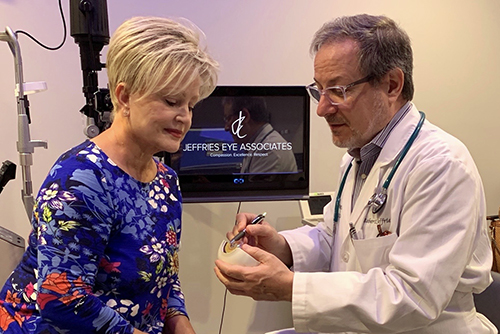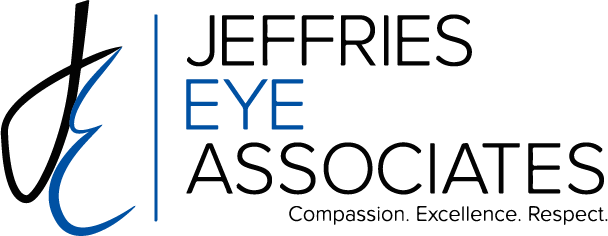Cataracts
What is a cataract?
A cataract is a clouding of the natural lens in the eye that affects vision. It has been said that if you live long enough, you will eventually get cataracts. In fact, everyone who lives into their late 60’s develops at least mild cataracts. The process of developing cataracts can be slow and take years to mature, so in the early stages of cataracts, simply changing your glasses prescription will usually restore your sight.
But as you continue to get older, the cataract gets more and more cloudy, and eventually not even a change in your glasses prescription will improve your sight. At that point, the only way to restore your vision is to remove the cataract.
With more than 3 million people undergoing cataract surgery every year, it is the most common surgical procedure performed on adults in the United States. Jeffries Eye Associates offers the most advanced technologies to diagnose, treat, and manage cataracts.
What causes a cataract?
Cataracts are caused mainly by age, trauma, heredity, and prolonged exposure to ultraviolet radiation. Some people are born with cataracts. Some develop cataracts from diabetes, steroid use, or smoking. And many people develop cataracts as they get older, even if there is no other medical reason.
What are cataract symptoms?
- Blurred, hazy or cloudy vision
- Halos around lights at night
- Glare from bright sunlight
- Washed out looking colors
- Frequent prescription changes
- Yellowing of images
- Double vision (rare)
Cataract Surgery
Cataract surgery involves the removal of the cloudy natural lens, and replacing it with a clear artificial lens. When you feel your vision loss interferes with your everyday activities such as driving, reading, or watching TV, it is time to consider cataract surgery.
The cloudy lens is removed with a tiny ultrasonic probe that enters your eye through a micro incision. Because the incision is so small, this “no-stitch” approach allows the incision to self-seal. The probe emits high-frequency ultrasonic vibrations to gently break up the cataract into tiny pieces so it can be removed much like a miniature vacuum cleaner.
Once the cataract is out, a new plastic-type lens called an Intraocular Lens (IOL) is inserted into the eye to restore clear vision. This new lens cannot be felt or sensed in any way by the patient. There are different types of IOLs that correct vision in different ways much like glasses. Your needs or how you want to see after surgery, will determine which lens is right for you.
Cataract surgery is performed on an outpatient basis at the new NWA Surgery Center, takes less than 30 minutes, and recovery is generally very quick. Because a mild sedative is used, you should have a friend or family member drive you home afterwards so you can rest.
For the first two weeks after surgery, you will need to wear an eye shield when sleeping to avoid rubbing your eye and administer medicated eye drops as prescribed. You should also avoid strenuous activities during this time. Most people are able to return to work after the first 48 hours, depending on their job requirements.
Intraocular Lens Options
Thanks to recent advancements in technology, Jeffries Eye is pleased to offer several options that may help you not only eliminate your cataracts, but also allow you to see up close, in the distance, and everything in between…with little to no dependence on glasses and contacts! At your cataract evaluation visit, we will discuss the lens options that you are a good candidate for and take the time to guide you through the process of helping you determine the option that best fits your needs and lifestyle.
Standard (Monofocal) Lens
You can choose to have a standard monofocal lens implanted which will allow for clear vision at one distance only (typically distance vision). With standard monofocal lenses, most patients still require glasses after cataract surgery for reading and other up-close activities. Virtually all monofocal IOLs are categorized as a “standard” lens and are typically covered by Medicare and insurance.
Advanced Technology (Multifocal) Lens
Or you can choose to upgrade to an Advanced Technology Lens. An Advanced Technology Lens not only corrects your distance vision, but can also correct other pre-existing vision conditions such as presbyopia (the need for reading glasses) and astigmatism. If you suffer from presbyopia and from cataracts, a multifocal IOL can give you distance vision along with enhanced intermediate and near vision, and that means reducing your dependency on glasses! Or, if you need correction for astigmatism, a Toric IOL might be right for you. Toric IOLs correct for a blurred or shadowed view caused by moderate to high astigmatism. Multifocal and Toric IOLs are considered Advanced Technology Lenses and typically are not covered by Medicare or insurance. However, an Advanced Technology Lens can help you reduce or eliminate the need for glasses after cataract surgery, so many patients find this added cost well worth it.
Light Adjustable Lens (LAL)
The Light Adjustable Lens (LAL) is the only IOL that allows you and your doctor to design, trial, and customize your vision after cataract surgery. Adjustability takes cataract surgery to the next level by giving you the opportunity to “test drive” your vision and make adjustments. In an FDA study with 600 subjects, those who received the Light Adjustable Lens were twice as likely (as those who received a standard monofocal IOL) to achieve 20/20 vision without glasses.
Our Experienced Team
Dr. Jeffries brings extensive cataract surgery experience to his patients. In fact, he is the only eye surgeon that has provided continuous surgical care since 1997, the longest of any eye surgeon in NW Arkansas. Cataract surgery can be intimidating…however, it has become one of the safest and most effective surgical procedures performed today, with an estimated 3 million cataract surgeries performed every year in the United States. Our experienced team will take the time to listen to your needs and guide you through the cataract treatment process to ensure the best possible outcome.
Let us help…have questions or need to schedule a cataract consultation appointment? Call our office at 479.631.8900 or fill out a contact form here.



